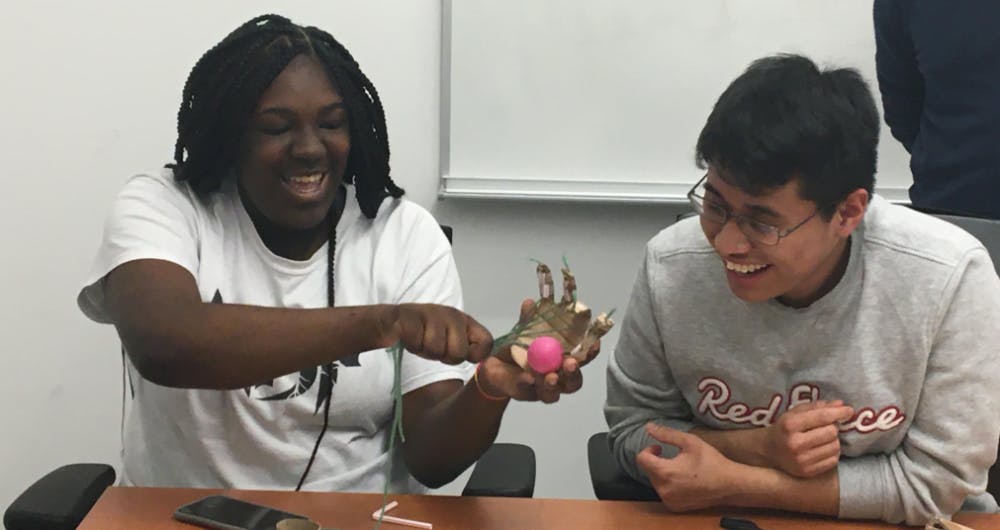By Garrett Cecere
Former Editor-in-Chief
Creation, teamsmanship and smiles filled the room as the students of Trenton Central High School (TCHS) assembled into their groups and put their creativity to work.
The students welcomed members of the College’s Bonner Community Scholars Program along with Johnson & Johnson to TCHS on Feb. 19. They participated in an activity that allowed students to put their engineering knowledge to the test while enjoying a moment of hands-on innovation with friends.
The high schoolers — all senior STEM students — were split into four groups and had a 30-minute time frame to use simple items to create makeshift prosthetic hands. Johnson & Johnson, the Bonner Community Scholars Program and the College’s iSTEM department helped coordinate the event.
According to Mitchell Joseph, a junior psychology major and Bonner student, the goal of the activity is for high schoolers to take away ideas that they will then use to lead similar activities for younger students.
“The plan with this is that the students are learning this activity, and then they’re going to teach the students over at the elementary school and … take the roles of the STEM students with them,” Joseph said.
Before the activity, Robbie Wetzel and Kayla DeVosa — both of whom are sophomore technology and engineering education majors in the Bonner Program — presented a slideshow to the students. They discussed the real-world application of prosthetic limbs and famous people who have a missing arm or hand, such as NFL linebacker Shaquem Griffin and Def Leppard drummer Rick Allen.
The presentation also included a video that showed the anatomy of the hand and how bones and muscles work together to move it.
Once the students were in their groups, they got to work using materials such as tape, straws, yarn, glue and cardboard. As Wetzel observed a group, he noted the importance of letting the students be inventive.
“We like to keep it open to imagination and creativity,” Wetzel said. “You know that no two designs are going to be the same.”
As the groups made their projects, some used straws to mimic the bone structure of a hand. Others attached yarn to each of the fingers so they could pull it and allow the hand to squeeze.
But building the hands was just the first part. The students then had to test them by picking up items, such as bottles or tubes of toothpaste. Representatives from Janssen Pharmaceuticals — which is part of Johnson & Johnson — observed the groups and served as judges for the activity. Business analyst José Hernandez admired the students’ strategy as they built.
“It was fun to see the kids think about … ‘how are we going to do that? How are we going to design (the hand)?’” he said. “And then, everyone having a separate responsibility ... one’s doing the cutting, one was doing the thinking of the functionality of the hand. So it was fun to see that.”
Although one group received first place, all the high schoolers showed excitement for gaining practice and using skills that they hope to pass down to younger students.
Destiny De La Rosa, one of the site coordinators for the Bonner Program’s education division, enjoyed the students’ takeaway of applying prosthetics to the real world.
“It was good to have the TCNJ iSTEM students here to really be able to guide them in an understanding that … something that you may not think is important and use every day (like a hand), we take it for granted,” she said.
According to Joseph, the Bonner Program has already worked with the chemistry department to coordinate a similar event earlier this month. The program will work with the physics department in March.
De La Rosa ultimately admired the students’ desire to learn and apply their talents.
“I love the students’ curiosity and their way to learn information and use their imagination to ultimately achieve a task,” she said. “Today’s task was to create a prosthetic hand, but tomorrow, it can be completely something different.”







